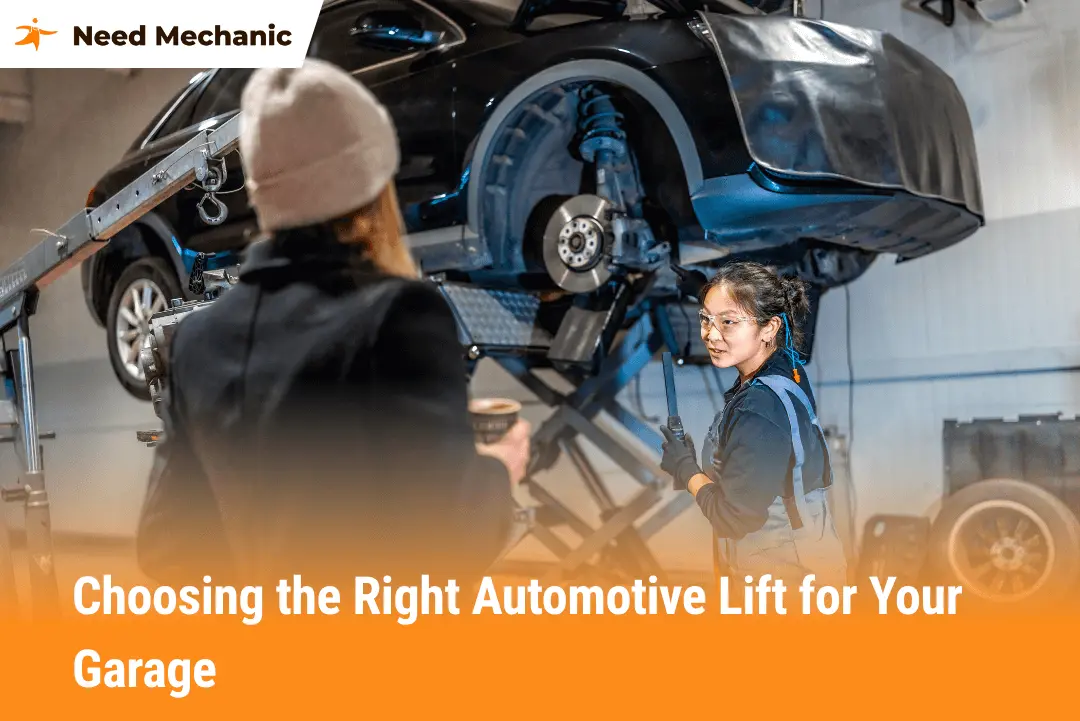The three main types of automotive lifts are two-post lifts, four-post lifts, and scissor lifts. These are the most common systems used in auto repair shops and home garages, each designed for different needs such as heavy-duty repairs, vehicle storage, or quick service jobs. Understanding how these lifts work and what benefits they provide will help you choose the right one for your situation.
If you’ve ever visited a repair shop and noticed cars raised high above the ground, chances are they were supported by one of these lift types. Automotive lifts are essential for safe, efficient car maintenance, and knowing the differences between the three main types can make a big difference whether you’re a mechanic, shop owner, or car enthusiast.
Table of Contents
Why is Automotive Lift Important?
Automotive lifts are essential because they allow heavy vehicles to be raised safely and efficiently, giving mechanics full access to work underneath without relying on unsafe jacks or ramps. Cars typically weigh between 3,000 and 6,000 pounds, and without lifts, even simple repairs would be dangerous, slow, and impractical.
Lifts improve the entire repair process by:
- Improving safety: They create a stable and secure platform for working under cars.
- Saving time: Mechanics can raise or lower vehicles to the right height quickly.
- Increasing productivity: Shops can service more cars each day with less effort.
- Making repairs more accurate: Better access means repairs can be done correctly the first time.
In short, the auto repair industry depends on lifts. Understanding the types of automotive lifts shows how safety, efficiency, and technology come together to make car maintenance faster and more reliable.
The Three Main Types of Automotive Lifts
1. Two-Post Lifts
Two-post lifts are some of the most common types you’ll see in auto shops. They have two strong vertical posts with arms that extend under the car. Once the arms are positioned, the car is lifted by its frame or designated lift points.
Key Benefits of Two-Post Lifts:
- Space-efficient: Ideal for smaller garages because they don’t take up much floor space.
- Versatile: Can handle a wide range of vehicles, from small sedans to light trucks.
- Affordable: Usually cost less than four-post lifts, making them popular for startups or home garages.
- Full under-car access: Since the wheels are often suspended, mechanics can easily work on brakes, suspension, or exhaust systems.
Best Uses:
Two-post lifts are perfect for general repair shops, tire and brake service, and even hobbyists working at home.
2. Four-Post Lifts
Four-post lifts use four sturdy columns to support a vehicle. Instead of arms, they have drive-on ramps that let cars roll into position before being raised.
Key Benefits of Four-Post Lifts:
- Higher weight capacity: Can handle heavier vehicles like large trucks and SUVs.
- Great for storage: Many car enthusiasts use them to store one car above another in the same space.
- User-friendly: Easier for beginners to use since the car drives directly onto the platform.
- Flexible use: Can be used for wheel alignment, routine inspections, or long-term storage.
Best Uses:
Four-post lifts are commonly found in shops that work with heavier vehicles or offer wheel alignment services. They’re also popular with collectors or homeowners who want to maximize garage space. When people search for “car lift for storage,” they’re almost always talking about four-post lifts.
3. Scissor Lifts
Scissor lifts get their name from the crisscross design of their lifting arms, which open and close like a pair of scissors. They raise vehicles by pushing the platforms upward in a vertical motion.
Key Benefits of Scissor Lifts:
- Compact design: Great for shops with limited space.
- Portable options: Some models can be moved around, making them flexible for different work areas.
- Quick setup: Vehicles can be lifted in seconds.
- Affordable entry point: Smaller scissor lifts are less expensive than most two- or four-post lifts.
Best Uses:
Scissor lifts are often used for tire shops, quick oil changes, or small garages where space is tight. They’re not ideal for major under-car repairs since access can be limited, but for quick service jobs, they’re extremely practical.
Comparing the Three Types of Automotive Lifts
To help visualize the differences, here’s a simple comparison of the three main types:
| Feature | Two-Post Lift | Four-Post Lift | Scissor Lift |
| Space Needed | Small | Medium to Large | Small |
| Vehicle Access | Full under-car | Full but wheels rest | Limited under-car |
| Best For | Repairs & service | Heavy vehicles & storage | Quick service jobs |
| Weight Capacity | Medium | High | Low to Medium |
| Cost | Moderate | Higher | Lower to Moderate |
This breakdown shows that no single lift is “best” overall. Instead, the right choice depends on the user’s needs, whether that’s quick service, heavy-duty repairs, or space-saving storage.
How to Choose the Right Lift for Your Needs
When deciding between the types of automotive lifts, think about:
- Your space – Do you have a small home garage or a large repair shop?
- Your vehicle type – Are you working on small cars, heavy trucks, or a mix of both?
- Your purpose – Do you need it for professional repairs, home maintenance, or vehicle storage?
- Your budget – Two-post lifts are often cheaper, while four-post lifts and heavy-duty scissor lifts cost more.
- Safety considerations – Always choose a lift with the right weight rating for your vehicle.
By weighing these factors, you can choose the lift that gives you the best combination of safety, convenience, and value.
Safety Tips for Using Automotive Lifts
No matter which type you use, safety should always come first. Here are some essential tips:
- Always check the lift’s weight capacity before raising a vehicle.
- Position arms or ramps correctly at the manufacturer’s lift points.
- Never work under a vehicle without confirming it is securely locked in place.
- Keep the area around the lift clear of tools and clutter.
- Perform regular maintenance checks on the lift itself.
These steps protect both the vehicle and the person working on it.
Final Thoughts
When people search for types of automotive lifts, they want clear, practical answers. The three main types are two-post lifts, four-post lifts, and scissor lifts, and each serves a unique purpose. Two-post lifts are great for general repairs and small shops, four-post lifts are excellent for heavy vehicles and storage, and scissor lifts are ideal for compact spaces and quick services.
Choosing the right one depends on your space, vehicle type, and goals. What’s most important is that these lifts make auto repair safer, faster, and more efficient. Whether you’re a professional mechanic or a car enthusiast working from home, understanding these lift types gives you the confidence to pick the right equipment and get the job done properly.
FAQs
What are the three main types of automotive lifts?
The three main types are two-post lifts, four-post lifts, and scissor lifts, each designed for different needs such as repairs, storage, or quick services.
Why are automotive lifts important?
They make it safe and efficient to lift heavy vehicles, improving safety, speed, productivity, and accuracy in auto repair.
What are the benefits of a two-post lift?
Two-post lifts are space-efficient, versatile, affordable, and provide full under-car access for repairs.
When should you choose a four-post lift?
Four-post lifts are best for heavy vehicles, long-term storage, and wheel alignment. They are user-friendly and maximize garage space.
What are the advantages of a scissor lift?
Scissor lifts are compact, portable, quick to set up, and affordable, making them ideal for small garages and quick service jobs.
How do I choose the right lift for my needs?
Consider your space, vehicle type, purpose (repairs, storage, or maintenance), budget, and safety requirements before choosing.
What safety tips should I follow when using lifts?
Check weight limits, position arms/ramps correctly, ensure the vehicle is locked, keep the area clear, and perform regular lift maintenance.





Leave a Reply